1
Active bents are interspersed with historic bents18 January 2011
Kinsol Trestle, Cowichan Valley, Vancouver Island, BC Canada
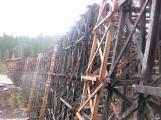 Credits:
Credits:Shawnigan Lake Historical Society
2
The terms "preservation" or "restoration" have been used to describe the retention of the Kinsol Trestle as a heritage structure. The correct term, "rehabilitation", is now regularly employed in discussions of this railway bridge. "Conservation" is another word used to describe the work being undertaken on the trestle. Each of these terms has a different meaning, although there are similarities. "Standards and Guidelines for the Conservation of Historic Places in Canada" provides definitions for these terms. See the "Definitions" storyline for more detail on these terms.Once the funding issues to rehabilitate the Kinsol Trestle were resolved by securing several government grants and establishing a fundraising campaign, the CVRD hired a team of experts to undertake the work. Work began in July 2010 and was completed in July 2011.
The Kinsol Trestle was built as a working railway bridge and constructed to bear the weight of trains and the heavy loads of natural resources they transported. This kind of load-bearing capability was not a consideration for the team who are conserving the trestle. The rehabilitated bridge, as the completed link in the Cowichan Valley Trail (within the Trans Canada Trail system) will be used for pedestrian, equestrian and cycling traffic only.
The trestle is made up of a series of fourty-four bents and two abutments. In the rehabilitated bridge, some bents are "active" meaning that they must bear more than their own weight, and others are "inactive" meaning they need only bear their own weight. Since the rehabilitation began, several of the active bents and Howe trusses have been reinforced to carry the loads of both light traffic and a new superstructure that will replace the original bridge deck. The superstructure will include a walkway that will be (614 ft.) long. The remaining inactive bents and Howe trusses have been stabilized and will be self-supporting. The advantage of this approach is that it allows for retention of historic building fabric where loads are less demanding. The original bridge was overbuilt. As a result, the rehabilitation has benefitted from redundancies such as extra timber and trusses.
3
New bents stacked beside Trestle2011
Kinsol Trestle, Cowichan Valley, Vancouver Island, BC Canada
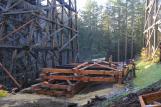 Credits:
Credits:Macdonald & Lawrence Timber Framing, photo credit
4
Heritage conservation specialist Macdonald & Lawrence Timber Framing Co. Ltd. was hired by the CVRD as the general contractor for the initial and final phases of the project. Adhering to best practices outlined in the "Standards and Guidelines for the Conservation of Historic Places in Canada", the M&L team is responsible for preserving the historic fabric of the bridge and the conservation of the structure in preparation for the second phase of the project. Dave O'Laney is a heritage conservation specialist for M & L.AUDIO: Dave O'Laney
One of the key roles of Macdonald & Lawrence as the stewards of the historic conservation part of the project is tracking each piece of wood. It doesn't matter necessarily where it ends up; the important thing, as part of the "Standards and Guidelines of the Conservation of Historic Places", is to track every piece…I, myself, as the conservation specialist, I'm really focused on the historic wood. What we were doing, and one of my roles, was to assess the wood as it came off (the trestle). So we would take down a bent and I would assess each post, stick by stick, determine whether or not they had the specifications that they could go back in…First of all, as many as those (historic pieces) are going back into the inactive (bents) as possible. What I mean by inactive, we're doing the same thing in situ, which means we're not taking them down, we're going to work one piece at a time, replacing what needs to be replaced - in the inactive bent. There's a lot less work to do - they only have to support their own weight, so the specifications are a little different. In that sense, we can replace a deteriorated post with an historic post, so long as it meets the specifications.
The Kinsol Trestle's situation in the wilderness, where access is limited, makes it an especially difficult place for a construction project.
AUDIO: Dave O'Laney
The first thing I would talk about when it comes to challenges is the location; it has been a significant challenge. There are only two roads in - both are narrow, winding gravel roads. When it snows and gets icy, like it has in the last couple weeks, trucks are not moving quickly on that road and some of them just, flat out, can't make it. So the location is definitely a challenge. It's a challenge to get cellphone service out there, and the internet. So when you've got a permanent crew out there for over a year, that's difficult and challenging when communication is an issue off-site. So that's an interesting challenge that we've been able to overcome the best that we can. It's funny, because every subcontractor that comes on-site recognizes that right away. There are some unique location challenges and geographic challenges; of course, the hill itself is also a significant challenge. The other day we had four cranes on site - all active - and a giant Caterpillar had to lower each one up and down the hill, because it's too dangerous to even try to negotiate the hill without that kind of backup. They had to build engineered crane pads for these large cranes, and in order to build those they had to run gravel trucks up and down the hill, again, everyone one of those gravel trucks had to be lowered down by a Caterpillar and brought back up by a Caterpillar.
5
Dave O'Laney, heritage conservation specialist, discusses his work20 January 2011
Duncan, BC, Canada
 Credits:
Credits:Dave O'Laney, Speaker
Cowichan Valley Musuem & Archives
6
Aerial view of damaged Trestle1992
Kinsol Trestle, Cowichan Valley, Vancouver Island, BC Canada
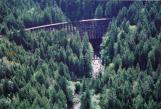 Credits:
Credits:Shawnigan Lake Historical Society
Ed Donald
7
Dave O'Laney describes challenges the project team faced20 January 2011
Kinsol Trestle, Cowichan Valley, Vancouver Island, BC Canada
 Credits:
Credits:Dave O'Laney, Speaker
Cowichan Valley Musuem & Archives
8
As the rehabilitation work proceeded, the team must responded quickly to problems that arose, while undertaking repairs that retain the maximum amount of historic fabric. New technologies were applied to historic timber pieces that are especially vulnerable in BC's wet climate.AUDIO: Dave O'Laney
I do know from a maintenance perspective the one thing we are doing is we are treating the wood, not treating it with any kind of harsh chemicals, like creosote or the other chemicals that are there. We are using something called Cobra Rods, which are these one-inch-thick rods, maybe six inches long. What we did is we drove them into the wood that is most susceptible to decay, to moisture, anywhere around the bolt locations, and this is all based on our condition assessment of where the historic wood is decaying the most, typically around the bolts and anywhere that's touching the ground - the bottom sills, for instance, are in some of the worst condition. So what we're doing is putting untreated wood down but we're shooting these rods, which are called Cobra Rods, into the wood. And what they do is that they maintain their integrity until the wood inside reaches 25 per cent moisture, and then they release and they shoot a chemical out that soaks up the moisture. And so it's a very interesting kind of process and way to tackle the inevitable decay that happens with all wood outside.
Maintenance of the trestle presented engineering challenges, such as replacing the sills at ground level. Over the course of the rehabilitation former CN workers visited the site often offering solutions.
AUDIO: Dave O'Laney
One thing that's interesting to us is we have to take out a few posts in situation - all the inactive bents in situ - so we have to devise a way to lift a bent up two inches, all together at one time, so that, let's say, so that one sill can be removed and a new one put in. Now Gord's (Macdonald) done a lot of research into that because it's not an easy question to answer; a lot of structural engineers have looked at it and kind of scratched their heads and wondered how we're going to do it. We have relied heavily on historical documents and Gord has gone to and read these CN reports on how they did it. We will most likely use a very old technique to do it because, quite frankly, it's the best technique anybody's ever come up with. Now, that being said, we'll probably put our own little twist on it, with new materials and new technologies, but in the end, it's probably going to be an awful lot of jacks, slowly lifting it up one or two inches.
Kathryn Gagnon:
I think that was a problem that was discussed when I brought a fellow named Gerry Flowers to the site...
Dave O'Laney:
Yeah, I recall.
Kathryn Gagnon:
And I think Gord has asked him about that specific problem.
Dave O'Laney:
And I believe Gerry had an answer for him in fact, and although we haven't been able to put into practice and we don't know how it's going to work yet, the philosophy is based around the idea of what Gerry and some of the other workers on the bridge had, yeah, absolutely. Sometimes the simplest ideas are the best. But that being said, we haven't got to that phase yet, so it will be interesting to see how we adapt the old techniques to the new situation.
9
Dave O'Laney explains use of new technologies20 January 2011
Kinsol Trestle, Cowichan Valley, Vancouver Island, BC Canada
 Credits:
Credits:Dave O'Laney, Speaker
Cowichan Valley Musuem & Archives
10
Dave O'Laney addresses challenges of project20 January 2011
Kinsol Trestle, Cowichan Valley, Vancouver Island, BC Canada
 Credits:
Credits:Dave O'Laney, Speaker
Cowichan Valley Musuem & Archives
11
Placing first new steel truss on north side2011
Kinsol Trestle, Cowichan Valley, Vancouver Island, BC Canada
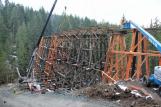 Credits:
Credits:Macdonald & Lawrence Timber Framing, photo credit
12
As the Kinsol Trestle is a heritage conservation project, the team is expected to retain the character-defining elements, such as the inspection ladders and the old telegraph poles. Before the rehabilitation began, the poles were photographed, and their locations on-site were measured. One of the poles was removed for safekeeping and will be returned to its original location at the end of the project. Dave O'Laney notes that, "Heritage details around the project, the way the Roman numerals are carved or scribed into the wood...is something we've continued with the new pieces of wood: every new piece of wood has the old Roman numerals on them, just because we want to stay consistent and true to the project."AUDIO: Dave O'Laney
Part of good heritage conservation, or good heritage conservation practice, is making the new wood distinguishable from the old. We're not trying to copy the wood exactly; we're not trying to make it look exactly like the old wood. We want to be able to tell, and we want the average person to be able to tell, what's new and what's old. As the new wood ages and becomes closer in patina to the old wood, that would get more and more challenging.
13
Dave O'Laney discusses a tenet of heritage conservation20 January 2011
Kinsol Trestle, Cowichan Valley, Vancouver Island, BC Canada
 Credits:
Credits:Dave O'Laney, Speaker
Cowichan Valley Musuem & Archives
14
Identification code, hand chiseled into new timbers18 January 2011
Kinsol Trestle, Cowichan Valley, Vancouver Island, BC Canada
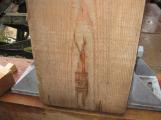 Credits:
Credits:Shawnigan Lake Historical Society